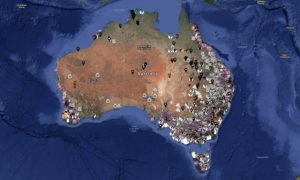The Guardian (International Edition)
Aussie Farms says online map will allow consumers to make ‘informed choices’
The agriculture minister has appealed to an animal activist group to pull down a website showing the location of hundreds of farms and abattoirs across Australia over concerns it will promote vigilantism and trespassing.
A group called Aussie Farms has published a satellite map showing the location of hundreds of farms and abattoirs and is encouraging people to upload photos and videos of animal exploitation.
David Littleproud, has dismissed the group’s activities as an “anonymous farm-shaming website” with no real outcomes for animal welfare.
“The reality is farmers are doing nothing wrong. They are doing what is well within their legal rights and shouldn’t have this hanging over them,” the minister told reporters in Toowoomba.
“The reality is that the federal government may have little recourse,” he said.
“I ask them to look into their own soul and do the right thing.”
He flagged a possible investigation into the group’s charity status.
“Putting the locations of farms online could be creating an attack map for activists “This will potentially result in illegal behaviour by activists,” Littleproud said.
“We don’t know if the footage posted on this website is actually from the farm it is attributed to. Content such as graphic images or video can be uploaded and attached to any farm by anonymous users.”
The National Farmers’ Federation president, Fiona Simson, said the map was unacceptable and posed a security risk.
“It’s about people going about their average daily business … and having vigilantes burst in on them supposedly just to check that everything is OK,” she told ABC Radio on Tuesday morning.
Asked what evidence there was that vigilantes were bursting in on farms, Simpson cited two examples by unknown activists – one at a property in the Glass House Mountains in Queensland and at the Gippy Goat cafe in west Gippsland Victoria. She did not suggest the Aussie Farms website was linked to those incidents.
Simson said the federation was exploring the legality of the map and wanted Facebook to shut down the group.
“Where I think the line blurs is, when does activism turn into terrorism? That’s what we are asking here now,” she told ABC Radio National. “By putting online people’s private details, by exposing people to anybody who wants to look it up online … We are crossing a line here.”
The group has been around since 2014 and is based out of Ryde, New South Wales.
Its objective is to “end commercialised animal abuse and exploitation in Australian animal agriculture facilities by increasing industry transparency and educating the public about modern farming and slaughtering practices”.
Simson insisted family farms were adhering to strict welfare standards and said activists caused stress to animals by coming in the middle of the night and shining lights on them and waking them up.
She defended the federation’s efforts to stamp out exploitation and said it would work with legitimate animal welfare groups.
Aussie Farms has defended its tactics. The map project was developed over eight years shows the location of “factory farms, slaughterhouses and other animal exploitation facilities across Australia”.
“Naturally we’re receiving a lot of backlash from farmers already, because for so long they’ve been able to operate as they please, without scrutiny,” the group said on Facebook.
“All we trying to do is show the public, consumers of products, exactly what they are purchasing when they buy animal products,” he said. “This is where they come from and this is what those animals go through.”
He said every photo or video clip uploaded to the site was moderated first by a team of 10 people, unless it was from a trusted account.
Delforce said the organisation contacted the suppliers of photos for verification purposes.
“Activists have no interest in the homes of these farmers,” he said. “The only thing we’re interested in is the giant sheds where sometimes tens of thousands of animals are housed in horrible conditions for a very short life before brutal slaughter.”


